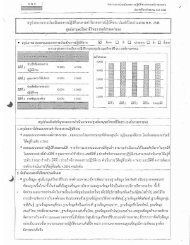Download
Download
Download
You also want an ePaper? Increase the reach of your titles
YUMPU automatically turns print PDFs into web optimized ePapers that Google loves.
The community forest movement often refers tolocal communities as forest people who are engaged in asubsistence economy. In the communities that I studied,however, villagers were generally more dependent on themarket than on the forest. While forest products providedfood supplies and extra income to the villagers of bothcommunities, the villagers were mainly dependent on cashcrops or on remittances from family members working inthe city to meet their other basic needs. In stark contrastto the prevailing image presented by the communityforest movement, their lifestyles were not those of thesubsistence livelihood forest dwellers, and farmland, notforest products, was the crucial resource for the villagers’survival.However, the community forest movement avoidsthe discussion of land rights for fear of their perceivedassociation with forest encroachment. As a result, theconstructed community rights discourse is mainly aboutthe rights to natural resources management, not aboutthe essential needs of the movement members: accessto forestland for viable commercial agriculture. This isevident from various drafts of the Community Forest Billproposed by the community forest movement in the pasttwo decades. While the debates on the Bill are mainlyabout whether communities should be allowed to manageprotected forest, every draft of the Community ForestBill prohibits land occupation, settlement, and farmingwithin the community forest. Literally speaking, therefore,even if the communities’ rights to manage communityforests were legally recognized, their residences andtheir farmland within the protected forest would still beat risk of eviction. The community forest activists hope,nevertheless, that if the communities were allowed a rolein forestry conservation, it would automatically follow thatthey would be allowed to stay in the forest.Rights in ContentionOn 29 September 2008, the National Human RightsCommission (NHRC) requested the Constitutional Court torule on the constitutionality of Article 6, the National ParkAct 1961 (B.E. 2504), which allows the government to decideto “reserve any land with interesting natural conditionsin order to maintain its condition for the educational andleisure purposes of the people” and demarcate that area0as protected forest. The demarcation of a protected areaentails the exclusion of human settlement from the area,including in the cases where local communities had settledthere before the area became protected forest. The NHRCargued that such a provision violated Section 66 and 67of the 2007 Constitution, which guarantees communityrights to natural resources management. The ConstitutionCourt ruled that the Article 6 of the National Park Act didnot affect human rights and is not unconstitutional. TheCourt backed the spirit of the Act to “protect the existingnatural resources … not to be destroyed or altered. Themain objectives are to protect and maintain public interestand the interest of the people in general 3 ”.The Constitutional Court’s decision reiteratesthe fact that a community’s rights to natural resourcesmanagement or, in fact, the rights to access naturalresources as a means of livelihood, are often placed inan inferior position to the national and public interests inpublic policy making. It also raises critical questions aboutthe community forest movement’s strategy of continuingto promote the idiom of “traditional culture” in compliancewith the national interest to protect the forest.The community rights discourse of the communityforest movement has been evolving and changingover the past two decades, and has made its wayinto Constitutional provisions and into the wider publicdiscourse. Nevertheless, the meaning and scope ofcommunity rights is still being negotiated, and the rightsneed to be better respected and protected. Approximately1.2 million people with de facto rights to live in protectedforest are still at risk of being evicted as long as their rightsto land and basic livelihoods are deemed as incompatiblewith the larger “public good” of forest conservation.Rather than focusing on representing communities as theliving embodiments of “traditional culture,” the questionthe movement needs to ask is as follows: how can acommunity’s right to livelihood and natural resourcesbe effectively balanced with the state’s goals for forestconservation?3 P. 4 The Royal Gazette, Vol. 129, Section 40 (Kor), dated 10 May 2012.







